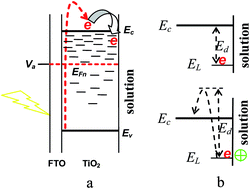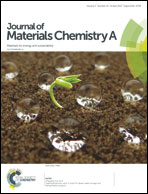Electron trapping induced electrostatic adsorption of cations: a general factor leading to photoactivity decay of nanostructured TiO2†
Abstract
In this work, a mechanism of electron trapping induced electrostatic adsorption of electrolyte cations (ETIEA) is proposed to explain the general photoactivity decay of nanostructured TiO2 electrodes, usually occurring during the initial several minutes of photoelectrochemical (PEC) processes. A series of designed “electron trapping” experiments and combined photo/electrochemical measurements revealed that it is the defect states of TiO2 that lead to ETIEA. A higher amount of surface defects will lead to larger ETIEA, which consequently accelerates the photoactivity decay. Different from the well-known “trap-filling” effect that decreases transport resistance, we find that the electron-trapping induced electrostatic attraction cannot make trap states inactive but can increase the detrapping energy barrier of trapped electrons. Our research reveals an important but easily overlooked fact, that is, carrier kinetics in nanostructured TiO2 may not be able to reach a steady state. In other words, a stable photocurrent may not be obtained because the photoelectrochemical process will alter the carrier dynamics constantly due to the existence of defect states. This result could also be applicable to other photoactive semiconductors.



 Please wait while we load your content...
Please wait while we load your content...